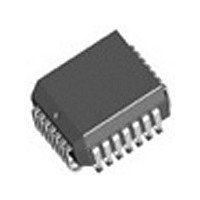EELXT360PE.A2SE001 Intel, EELXT360PE.A2SE001 Datasheet - Page 27

EELXT360PE.A2SE001
Manufacturer Part Number
EELXT360PE.A2SE001
Description
Manufacturer
Intel
Datasheet
1.EELXT360PE.A2SE001.pdf
(54 pages)
Specifications of EELXT360PE.A2SE001
Number Of Transceivers
1
Operating Supply Voltage (typ)
5V
Screening Level
Industrial
Mounting
Surface Mount
Operating Supply Voltage (min)
4.75V
Operating Supply Voltage (max)
5.25V
Operating Temperature (min)
-40C
Operating Temperature (max)
85C
Lead Free Status / RoHS Status
Compliant
2.7.3.5
2.7.3.6
2.7.4
2.7.4.1
Datasheet
HDB3 Code Violation Detection (CODEV)
An HDB3 code violation (CODEV) occurs when two consecutive bipolar violations of the same
polarity are received (refer to ITU O.161). When CODEV detection is enabled, the BPV pin goes
High for a full RCLK cycle to report a CODEV violation. Note that bipolar violations and zero
substitution violations will also be reported on the BPV pin if these options are enabled.
CODEV detection is not available in Hardware mode. In Host mode, HDB3 code violation
detection is enabled when the HDB3 encoders/decoders are enabled. This requires that
CR1.ENCENB = 1, also CR1.EC4:1 = 100x or 1010, which establishes E1 operation. To select
CODEV detection, set bit CR4.CODEV = 1.
HDB3 Zero Substitution Violation Detection (ZEROV)
An HDB3 ZEROV is the receipt of four or more consecutive zeros. This does not occur with
correctly encoded HDB3 data unless there are transmission errors. The BPV pin goes High for a
full RCLK cycle to report a ZEROV. Note that when ZEROV detection enabled, the BPV pin will
also indicate received BPVs and CODEVs, if these detection options are enabled.
ZEROV detection is not available in Hardware mode. In Host mode, HDB3 zero substitution
violation (ZEROV) detection is enabled when the HDB3 encoders/decoders are enabled. This
requires CR1.ENCENB = 1, also CR1.EC4:1 = 100x or 1010, which establishes E1 operation. To
select ZEROV detection, set bit CR4.ZEROV = 1.
Alarm Condition Monitoring
Loss of Signal (LOS)
The Loss of Signal (LOS) monitor function is compatible with ITU G.775 and ETSI 300233. The
receiver LOS monitor loads a digital counter at the RCLK frequency. The count increments with
each received 0 and the counter resets to 0 on receipt of a 1. When the count reaches “n” 0s, the
LOS flag goes High, and the MCLK replaces the recovered clock at the RCLK output in a smooth
transition. For Hardware mode T1 operations, the number of 0s, n = 175, and for Hardware mode
E1 operations, n = 32. In Host mode, either number can be changed to 2048 by setting bit
CR4.LOS2048 to 1.
For T1 operation, when the received signal has 12.5% 1’s density (16 marks in a sliding 128-bit
period, with fewer than 100 consecutive 0s), the LOS flag returns Low and the recovered clock
replaces MCLK at the RCLK output in another smooth transition.
For E1 operation, the LOS condition is cleared when the received signal has 12.5% 1’s density
(four 1s in a sliding 32-bit window with fewer than 16 consecutive 0s). In E1 Host mode operation,
the out-of-LOS criterion can be modified from 12.5% marks density to 32 consecutive marks by
setting bit CR4.COL32CM = 1.
During LOS, the device sends received data to the RPOS/RNEG pins (or RDATA in Unipolar
mode). In Hardware and Host modes, the LOS pin goes High when a LOS condition occurs. In
Host mode, bit PSR.LOS =1 indicates a LOS condition, and will generate an interrupt if so
programmed.
Integrated T1/E1 LH/SH Transceiver for DS1/DSX-1 or PRI Applications — LXT360
27











